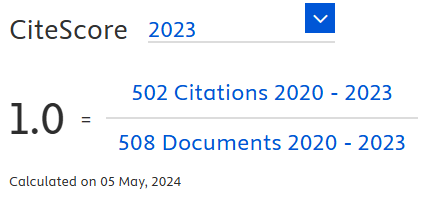Characterization and valorization of incinerated distillery spent wash ash with sugarcane bagasse: An environmental perspective
DOI:
https://doi.org/10.18006/2025.13(2).213.228Keywords:
Distillery, Spent wash incinerated ash, Zero Liquid Discharge (ZLD), Organic pollutantAbstract
Distilleries that use sugarcane molasses are among the most polluting industries in India. Many of these distilleries have recently adopted zero liquid discharge (ZLD) practices by incinerating distillery spent wash, which produces a large amount of incinerated ash as solid waste. This distillery's spent wash ash is often applied to agricultural practices as a source of potash without considering its other physicochemical properties. Therefore, the primary aim of this study is to characterize the incinerated spent wash ash to identify its organic and inorganic constituents for potential sustainable development applications while avoiding adverse effects on soil. The complete analysis of the ash revealed an alkaline pH of 9.50 ± 0.85, along with various salts and heavy metals, such as iron, nickel, and chromium (ranging from 2335.21 to 2363.00 mg/kg), as well as nitrogen (10400-11312 mg/kg) and potassium (11314.80-13550.00 mg/kg). Additionally, organic compounds like 2,4-dimethylbenzene and dichloroacetic acid, which are toxic and potentially carcinogenic, were detected. Seed germination tests using Vigna radiata showed that even at low concentrations (2%), the ash inhibited growth, with radicles being more negatively affected than plumules. These findings confirm that fresh incinerated ash is highly toxic and unsuitable for direct agricultural use. The study recommends proper optimization through composting or other degradation techniques to detoxify the ash before disposal, thereby contributing to sustainable waste management practices.
References
Adnan, M., Rasul, A., Hussain, G., Shah, M. A., Sarfraz, I., et al. (2021). Physcion and physcion 8-O-β-D-glucopyranoside: Natural anthraquinones with potential anticancer activities. Current Drug Targets, 22(5), 488-504. DOI: https://doi.org/10.2174/18735592MTEwDNjQiz
Al-Busaidi, A. S., & Cookson, P. (2003). Salinity–pH relationships in calcareous soils. Journal of Agricultural and Marine Sciences [JAMS], 8(1), 41-46. DOI: https://doi.org/10.24200/jams.vol8iss1pp41-46
American Public Health Association [APHA] (2012). Standard Method for Examination of Water and Wastewater, 22nd Edn. Washington, DC: American Public Health Association.
Api, A. M., Smith, R. L., Pipino, S., Marczylo, T., & De Matteis, F. (2004). Evaluation of the oral subchronic toxicity of AHTN (7-acetyl-1, 1, 3, 4, 4, 6-hexamethyl-1, 2, 3, 4-tetrahydronaphthalene) in the rat. Food and chemical toxicology, 42(5), 791-801. DOI: https://doi.org/10.1016/j.fct.2003.12.016
Asberry, H. B., Kuo, C. Y., Gung, C. H., Conte, E. D., & Suen, S. Y. (2014). Characterization of water bamboo husk biosorbents and their application in heavy metal ion trapping. Microchemical Journal, 113, 59-63. DOI: https://doi.org/10.1016/j.microc.2013.11.011
Balasubramanian, S., & Kannan, P. (2016). Spent wash/vinasse/stillage incineration technology. Proceedings of the Annual Congress - South African Sugar Technologists' Association, 2016 (89), 487-497
Bharagava, R. N., & Chandra, R. (2010). Effect of bacteria treated and untreated post-methanated distillery effluent (PMDE) on seed germination, seedling growth and amylase activity in Phaseolus mungo L. Journal of Hazardous Materials, 180(1-3), 730-734. DOI: https://doi.org/10.1016/j.jhazmat.2010.04.100
Bharagava, R. N., Chandra, R., & Rai, V. (2008). Phytoextraction of trace elements and physiological changes in Indian mustard plants (Brassica nigra L.) grown in post methanated distillery effluent (PMDE) irrigated soil. Bioresource Technology, 99(17), 8316-8324. DOI: https://doi.org/10.1016/j.biortech.2008.03.002
Bharagava, R. N., Chandra, R., & Singh, S. K. (2006). Elucidation of Chernical Structure of Phenolic Compounds by Hº NME anci GC-Mass Spectrometry Present in Anaerobically Digested Distillery Effluent. Indian Journal of Environmental Protection, 26 (11), 1015-1018.
Bhardwaj, S., Ruhela, M., Bhutiani, R., Ahamad, F., & Bhardwaj, R. (2019). Distellery spent wash (DSW) treatment methodogies and challenges with special reference to incineration: An overview. Environment Conservation Journal, 20(3), 135-144. DOI: https://doi.org/10.36953/ECJ.2019.20318
Brahmbhatt, V. V., Nold, C., Albert, C. J., & Ford, D. A. (2008). Quantification of pentafluorobenzyl oxime derivatives of long chain aldehydes by GC–MS analysis. Lipids, 43, 275-280. DOI: https://doi.org/10.1007/s11745-008-3153-x
Cao, C. W., Niu, F., Li, X. P., Ge, S. L., & Wang, Z. Y. (2014). Acute and joint toxicity of twelve substituted benzene compounds to Propsilocerus akamusi Tokunaga. Open Life Sciences, 9(5), 550-558. DOI: https://doi.org/10.2478/s11535-014-0289-y
Chandra, R. (2000). Microbial Pre-Treatment for Desulfurisation of Distillery Effluent For Improvement of Biomethanation. Pollution Research, 19(3), 471-474.
Chandra, R., & Bharagava, R. N. (2007). Microbial Degradation of Melanoidin: A major Environmental Pollutant of Distillery Waste. New Frontiers of Environmental Biotechnological Application, (pp. 99-134). Published by ENVIS Centre on Environmental Biotechnology. DOI: https://doi.org/10.1016/j.biortech.2007.09.057
Chandra, R., & Kumar, V. (2017). Detection of androgenic-mutagenic compounds and potential autochthonous bacterial communities during in situ bioremediation of post-methanated distillery sludge. Frontiers in microbiology, 8, 887. DOI: https://doi.org/10.3389/fmicb.2017.00887
Chandra, R., & Kumar, V. (2017b). Detection of Bacillus and Stenotrophomonas species growing in an organic acid and endocrine-disrupting chemical-rich environment of distillery spent wash and its phytotoxicity. Environmental Monitoring and Assessment, 189, 1-19. DOI: https://doi.org/10.1007/s10661-016-5746-9
Chandra, R., Bharagava, R. N., Yadav, S., & Mohan, D. (2009). Accumulation and distribution of toxic metals in wheat (Triticum aestivum L.) and Indian mustard (Brassica campestris L.) irrigated with distillery and tannery effluents. Journal of hazardous materials, 162(2-3), 1514-1521. DOI: https://doi.org/10.1016/j.jhazmat.2008.06.040
Chandra, R., Yadav, S., & Mohan, D. (2008). Effect of distillery sludge on seed germination and growth parameters of green gram (Phaseolus mungo L.). Journal of hazardous materials, 152(1), 431-439. DOI: https://doi.org/10.1016/j.jhazmat.2007.06.124
David Noel, S., & Rajan, M. R. (2015). Phytotoxic effect of dyeing industry effluent on seed germination and early growth of lady's finger. Journal of Pollution Effects & Control, 2(126), 10-4172.
Debnath, A., Sengupta, A., Saha, A., & Das, A. (2022). Utilization of agro waste for beneficial product formulation. Journal of Experimental Biology and Agricultural Sciences, 10(1), 157-170. DOI: https://doi.org/10.18006/2022.10(1).157.170
Doty, R. L. (2015). Neurotoxic exposure and impairment of the chemical senses of taste and smell. Handbook of clinical neurology, 131, 299-324. DOI: https://doi.org/10.1016/B978-0-444-62627-1.00016-0
Hu, W., Zheng, N., Zhang, Y., Li, S., Bartlam, M., & Wang, Y. (2024). Metagenomics analysis reveals effects of salinity fluctuation on diversity and ecological functions of high and low nucleic acid content bacteria. Science of The Total Environment, 933, 173186. DOI: https://doi.org/10.1016/j.scitotenv.2024.173186
Industrial Effluent Guidelines | US EPA (2002), Retreived from: https://www.epa.gov/eg/industrial-effluent-guidelines.
Kannan, A., & Upreti, R. K. (2008). Influence of distillery effluent on germination and growth of mung bean (Vigna radiata) seeds. Journal of Hazardous Materials, 153(1-2), 609-615. DOI: https://doi.org/10.1016/j.jhazmat.2007.09.004
Kumar, V., Shahi, S. K., Ferreira, L. F. R., Bilal, M., Biswas, J. K., & Bulgariu, L. (2021). Detection and characterization of refractory organic and inorganic pollutants discharged in biomethanated distillery effluent and their phytotoxicity, cytotoxicity, and genotoxicity assessment using Phaseolus aureus L. and Allium cepa L. Environmental Research, 201, 111551. DOI: https://doi.org/10.1016/j.envres.2021.111551
Kumari, S., Jose, S., Tyagi, M., & Jagadevan, S. (2020). A holistic and sustainable approach for recovery of phosphorus via struvite crystallization from synthetic distillery wastewater. Journal of Cleaner Production, 254, 120037. DOI: https://doi.org/10.1016/j.jclepro.2020.120037
Lan, J., Hu, M., Gao, C., Alshawabkeh, A., & Gu, A. Z. (2015). Toxicity assessment of 4-methyl-1-cyclohexanemethanol and its metabolites in response to a recent chemical spill in West Virginia, USA. Environmental science & technology, 49 (10), 6284-6293. DOI: https://doi.org/10.1021/acs.est.5b00371
Liu, Y., Chu, S., Yang, S., Peng, Y., Ren, S., Wen, B., & Chen, N. (2019). Physcion and physcion 8-O-β-glucopyranoside: A review of their pharmacology, toxicities and pharmacokinetics. Chemico-biological interactions, 310, 108722. DOI: https://doi.org/10.1016/j.cbi.2019.06.035
Ma, K., Kou, J., Rahman, M. K. U., Du, W., Liang, X., et al. (2021). Palmitic acid mediated change of rhizosphere and alleviation of Fusarium wilt disease in watermelon. Saudi Journal of Biological Sciences, 28(6), 3616-3623. DOI: https://doi.org/10.1016/j.sjbs.2021.03.040
Manwatkar, P., Dhote, L., Pandey, R. A., Middey, A., & Kumar, S. (2021). Combustion of distillery sludge mixed with coal in a drop tube furnace and emission characteristics. Energy, 221, 119871. DOI: https://doi.org/10.1016/j.energy.2021.119871
Minuti, L., Pellegrino, R. M., & Tesei, I. (2006). Simple extraction method and gas chromatography–mass spectrometry in the selective ion monitoring mode for the determination of phenols in wine. Journal of Chromatography A, 1114 (2), 263-268. DOI: https://doi.org/10.1016/j.chroma.2006.02.068
Mikucka, W., & Zielińska, M. (2020). Distillery stillage: characteristics, treatment, and valorization. Applied biochemistry and biotechnology, 192, 770-793. DOI: https://doi.org/10.1007/s12010-020-03343-5
Mukherjee, M., Chakraborty, S., Sarkar, S., Saha, S., Majumder, S., Ghosh, A., & Bhattacharya, M. (2020). Soil nutritional status of tea plantations in plains of sub Himalayan West Bengal, India. Current Agriculture Research Journal, 8(3). DOI : http://dx.doi.org/10.12944/CARJ.8.3.10 DOI: https://doi.org/10.12944/CARJ.8.3.10
Naz, M., Dai, Z., Hussain, S., Tariq, M., Danish, S., et al. (2022). The soil pH and heavy metals revealed their impact on soil microbial community. Journal of Environmental Management, 321, 115770. DOI: https://doi.org/10.1016/j.jenvman.2022.115770
Okeke, O. K., Isah, A. D., Shamaki, S. B., Abubakar, G. A., Nolisa, M. U., & Umar, Z. (2022). Assessment of Soil Organic Carbon and Total Nitrogen as Indicators for Soil Productivity in Gidan Amamata Eucalyptus (Eucalyptus globulus) Plantation, Sokoto State, Nigeria. Journal of Agriculture and Environment, 18, 107-114.
Patel, H. (2022). Characterization and adsorptive treatment of distillery spent wash using bagasse fly ash. Arabian Journal for Science and Engineering, 47(5), 5521-5531. DOI: https://doi.org/10.1007/s13369-021-05497-8
Qiu, X., Cao, L., & Han, R. (2020). Analysis of volatile components in different ophiocordyceps sinensis and insect host products. Molecules, 25(7), 1603. DOI: https://doi.org/10.3390/molecules25071603
Rodríguez-Díaz, J. M., García, J. O. P., Sánchez, L. R. B., da Silva, M. G. C., da Silva, V. L., & Arteaga-Pérez, L. E. (2015). Comprehensive characterization of sugarcane bagasse ash for its use as an adsorbent. Bioenergy Research, 8, 1885-1895. DOI: https://doi.org/10.1007/s12155-015-9646-6
Santal, A. R., Singh, N. P., & Saharan, B. S. (2011). Biodegradation and detoxification of melanoidin from distillery effluent using an aerobic bacterial strain SAG5 of Alcaligenes faecalis. Journal of hazardous materials, 193, 319-324. DOI: https://doi.org/10.1016/j.jhazmat.2011.07.068
Shi, Y., Li, Y., Yang, T., & Chu, H. (2021). Threshold effects of soil pH on microbial co-occurrence structure in acidic and alkaline arable lands. Science of the Total Environment, 800, 149592. DOI: https://doi.org/10.1016/j.scitotenv.2021.149592
Singh, K., Tripathi, S., & Chandra, R. (2023). Bacterial assisted phytoremediation of heavy metals and organic pollutants by Cannabis sativa as accumulator plants growing on distillery sludge for ecorestoration of polluted site. Journal of environmental management, 332, 117294. DOI: https://doi.org/10.1016/j.jenvman.2023.117294
Singh, V., Park, S. Y., Lee, E. S., Choi, J. H., Kim, C. G., & Srivastava, V. C. (2024). Investigation of co-combustion characteristics of distillery sludge and sugar mill waste: kinetics, synergy, and ash characterization. Environment, Development and Sustainability, 26(8), 21217-21236. DOI: https://doi.org/10.1007/s10668-023-03525-1
Singh, Y. P., Arora, S., Mishra, V. K., Dixit, H., & Gupta, R. K. (2018). Conjoint use of chemical amendments and municipal solid waste compost for amelioration of degraded sodic soil. Journal of the Indian Society of Soil Science, 66(4), 392-398. DOI: https://doi.org/10.5958/0974-0228.2018.00049.X
Singh, Y. (2020). https://www.wealthywaste.com/zero-liquid-discharge-standards-for-distilleries-in-uttar-pradesh-india-propriety-and-rationale retrieved from 29th December 2024.
Tripathi, S., Singh, K., Singh, A., Mishra, A., & Chandra, R. (2021). Organo-metallic pollutants of distillery effluent and their toxicity on freshwater fish and germinating Zea mays seeds. International Journal of Environmental Science and Technology, 19, 1-14. DOI: https://doi.org/10.1007/s13762-021-03233-1
Tripathi, S., Purchase, D., Chandra, R., Nadda, A. K., & Bharagava, P. C. (2022). Mitigation of hazards and risks of emerging pollutants through innovative treatment techniques of post methanated distillery effluent-A review. Chemosphere, 300, 134586. DOI: https://doi.org/10.1016/j.chemosphere.2022.134586
Vanitha, V., Vijayakumar, S., Nilavukkarasi, M., Punitha, V. N., Vidhya, E., & Praseetha, P. K. (2020). Heneicosane—A novel microbicidal bioactive alkane identified from Plumbago zeylanica L. Industrial Crops and Products, 154, 112748. DOI: https://doi.org/10.1016/j.indcrop.2020.112748
Wang, T., Lim, J. N., Lee, J. S., Lee, S. B., Hwang, J. H., et al. (2015). Effects of dietary trans 9 octadecenoic acid, trans 11 vaccenic acid and cis 9, trans 11 conjugated linoleic acid in mice. Molecular medicine reports, 12(2), 3200-3206. DOI: https://doi.org/10.3892/mmr.2015.3767
Yang, J., Li, W., Teng, D., Yang, X., Zhang, Y., & Li, Y. (2022). Metagenomic insights into microbial community structure, function, and salt adaptation in saline soils of arid land, China. Microorganisms, 10(11), 2183. DOI: https://doi.org/10.3390/microorganisms10112183
Zhang, W. W., Chong, W. A. N. G., & Rui, X. U. E. (2019). Effects of salinity on the soil microbial community and soil fertility. Journal of Integrative Agriculture, 18(6), 1360-1368. DOI: https://doi.org/10.1016/S2095-3119(18)62077-5
Zhao, Y., Qi, W.S., Bao, Z.C., Liu, Z.Q., & Ma, B.G. (2023). Effects of mine water irrigation on vertical distribution of soil DOI: https://doi.org/10.15666/aeer/2104_34833496
nutrients, salts and metals. Applied ecology & environmental research, 21(4), 3483-3496.
Downloads
Published
How to Cite
License
Copyright (c) 2025 Journal of Experimental Biology and Agricultural Sciences

This work is licensed under a Creative Commons Attribution-NonCommercial 4.0 International License.












